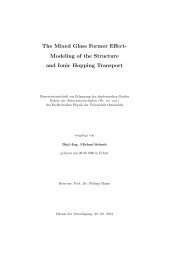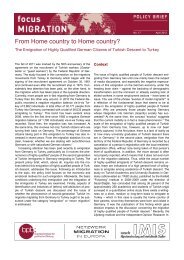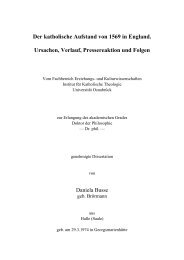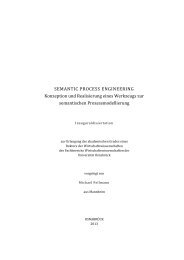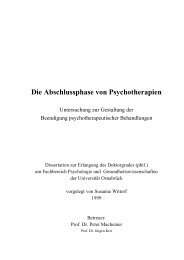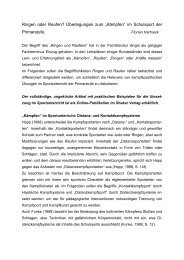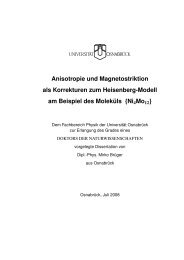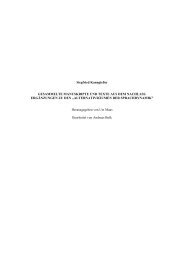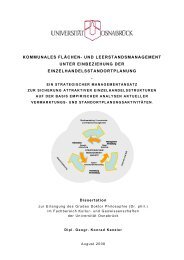336 Literatur BLEECKER, M. L., BOLLA-WILSON, K., AGNEW, J. & MEYERS, D. A. (1988). Age-related sex differences in verbal memory. Journal of Clinical Psychology, 44(3), 403-411. BLEULER, E. (1911). Dementia praecox oder die Gruppe der Schizophrenien. In G. ASCHAFFENBURG (Hrsg.), Handbuch der Psychiatrie, Spezieller Teil, 4. Abtheilung. Leipzig: Franz Deuticke. BÖKER, W. (1999). Störungswahrnehmung <strong>und</strong> <strong>Krankheitseinsicht</strong> schizophrener Patienten. Fortschritte der Neurologie, Psychiatrie, 67(6), 237-248. BOKAT, C. E. & GOLDBERG, T. E. (2003). Letter and category fluency in schizophrenic patients: A meta-analysis. Schizophrenia Research, 64(1), 73-78. BOLLES, M. & GOLDSTEIN, K. (1938). A study of the impairment of 'abstract behavior' in schizophrenic patients. Psychiatric Quarterly, 12, 42-65. BOLTON, B. & ROESSLER, R. (1986). The Work Personality Profile: Factor scales, reliability, validity, and norms. Vocational Evaluation & Work Adjustment Bulletin, 19(4), 143-149. BOLTON, C., GOODING, P., KAPUR, N., BARROWCLOUGH, C. & TARRIER, N. (2007). Developing psychological perspectives of suicidal behaviour and risk in people with a diagnosis of schizophrenia: We know they kill themselves but do we <strong>und</strong>erstand why? Clinical Psychology Review, 27(4), 511-536. BONANNO, G. A., DAVIS, P. J., SINGER, J. L. & SCHWARTZ, G. E. (1991). The repressor personality and avoidant information processing: A dichotic listening study. Journal of Research in Personality, 25(4), 386-401. BOONE, K. B., GHAFFARIAN, S., LESSER, I. M., HILL-GUTIERREZ, E. & BERMAN, N. G. (1993). Wisconsin Card Sorting Test performance in healthy, older adults: Relationship to age, sex, education, and IQ. Journal of Clinical Psychology, 49(1), 54-60. BORA, E., SEHITOGLU, G., ASLIER, M., ATABAY, I. & VEZNEDAROGLU, B. (2007). Theory of mind and unawareness of illness in schizophrenia: Is poor insight a mentalizing deficit? European Archives of Psychiatry and Clinical Neuroscience, 257(2), 104-111. BORA, E., YUCEL, M. & PANTELIS, C. (2009). Theory of mind impairment in schizophrenia: Meta-analysis. Schizophrenia Research, 109(1-3), 1-9. BORTZ, J. & DÖRING, N. (1995). Forschungsmethoden <strong>und</strong> Evaluation (2. Aufl.). Berlin: Springer. BOTVINICK, M. M., BRAVER, T. S., BARCH, D. M., CARTER, C. S. & COHEN, J. D. (2001). Conflict monitoring and cognitive control. Psychological Review, 108(3), 624-652. BRÉBION, G., SMITH, M. J., GORMAN, J. M. & AMADOR, X. (1997). Discrimination accuracy and decision biases in different types of reality monitoring in schizophrenia. Journal of Nervous and Mental Disease, 185(4), 247-253. BREZNITZ, S. (1988). The seven kinds of denial. In P. B. DEFARES (Hrsg.), Stress and anxiety (Vol. 11) (S. 73-90). New York: Hemisphere/Harper & Row. BRISLIN, R.W. (2000). Back-translation. In A. E. Kazdin (Hrsg.), Encyclopedia of psychology Vol. 1 (S. 359-360). New York: Oxford University Press. BRÜNE, M. (2005). 'Theory of Mind' in schizophrenia: A review of the literature. Schizophrenia Bulletin, 31(1), 21-42. BRUGGEMANS, E. F., VAN DE VIJVER, F. J. R. & HUYSMANS, H. A. (1997). Assessment of cognitive deterioration in individual patients following cardiac surgery: Correcting for measurement error and practice effects. Journal of Clinical and Experimental Neuropsychology, 19(4), 543-559. BRYSON, G., GREIG, T., LYSAKER, P. & BELL, M. (2002). Longitudinal Wisconsin Card Sorting performance in schizophrenia patients in rehabilitation. Applied Neuropsychology, 9(4), 203-209. BUCHANAN, A. (1992). A two-year prospective study of treatment compliance in patients with schizophrenia. Psychological Medicine, 22(3), 787-797. BUCHSBAUM, B. R., GREER, S., CHANG, W.-L. & BERMAN, K. F. (2005). Meta-analysis of neuroimaging studies of the Wisconsin Card-Sorting task and component processes. Human Brain Mapping, 25(1), 35-45. BUCKLEY, P. F., HROUDA, D. R., FRIEDMAN, L., NOFFSINGER, S. G., RESNICK, P. J. & CAMLIN-SHINGLER, K. (2004). Insight and its relationship to violent behavior in patients with schizophrenia. American Journal of Psychiatry, 161(9), 1712-1714. BUCKLEY, P. F., WIRSHING, D. A., BHUSHAN, P., PIERRE, J. M., RESNICK, S. A. & WIRSHING, W. C. (2007). Lack of insight in schizophrenia: Impact on treatment adherence. CNS Drugs, 21(2), 129-141. BUCKTING, J. L. (2008). Bewältigungsverhalten bei Schizophrenie: Übersetzung <strong>und</strong> Erprobung einer deutschen Version der „Coping Strategies Task“ (CST). Unveröffentlichte Diplomarbeit, Universität Osnabrück. BUDOFF, M. (1970). Learning potential: Assessing ability to reason in the educable mentally retarded. Acta Paedopsychiatrica, 37(9-10), 293-309. BUDOFF, M. & FRIEDMAN, M. (1964). 'Learning potential' as an assessment approach to the adolescent mentally retarded. Journal of Consulting Psychology, 28(5), 434-439. BUDOFF, M. & PAGELL, W. (1968). Learning potential and rigidity in the adolescent mentally retarded. Journal of Abnormal Psychology, 73(5), 479-486. BÜHLER, K.-E. & PAGELS, S. (2003). Der Einfluss von Biographie, Lebensereignissen <strong>und</strong> chronischen Schwierigkeiten auf den Verlauf stationärer Therapie Depressiver. Nervenheilk<strong>und</strong>e, 22(9), 475-481. BÜHNER, M. (2006). Einführung in die Test- <strong>und</strong> Fragebogenkonstruktion (2. Aufl.). München: Pearson Studium. BURGESS, P. W. & SHALLICE, T. (1996). Bizarre responses, rule detection and frontal lobe lesions. Cortex, 32(2), 241-259.
337 Literatur BURNS, J. W. (2000). Repression predicts outcome following multidisciplinary treatment of chronic pain. Health Psychology, 19(1), 75-84. BYRNE, D. (1961). The repression-sensitization scale: Rationale, reliability, and validity. Journal of Personality, 29(3), 334-349. CAMPBELL, J. D. (1990). Self-esteem and clarity of the self-concept. Journal of Personality and Social Psychology, 59(3), 538-549. CARLSON, J. S. & WIEDL, K. H. (1992). Principles of dynamic assessment: The application of a specific model. Learning and Individual Differences, 4(2), 153-166. CARLSON, J. S. & WIEDL, K. H. (2000). The validity of dynamic assessment. In C. LIDZ & J. G. ELLIOTT (Hrsg.), Dynamic assessment: Prevailing models and applications (S. 681-712). New York: Elsevier. CARROLL, A., FATTAH, S., CLYDE, Z., COFFEY, I., OWENS, D. G. C. & JOHNSTONE, E. C. (1999). Correlates of insight and insight change in schizophrenia. Schizophrenia Research, 35(3), 247-253. CARSKY, M., SELZER, M. A., TERKELSEN, K. G. & HURT, S. W. (1992). The PEH: A questionnaire to assess acknowledgment of psychiatric illness. Journal of Nervous and Mental Disease, 180(7), 458-464. CARVER, C. S., SCHEIER, M. F. & WEINTRAUB, J. K. (1989). Assessing coping strategies: A theoretically based approach. Journal of Personality and Social Psychology, 56(2), 267-283. CATON, C. L. M., HASIN, D. S., SHROUT, P. E., DRAKE, R. E., DOMINGUEZ, B., SAMET, S. & SCHANZER, B. (2006). Predictors of Psychosis Remission in Psychotic Disorders that Co-occur with Substance Use. Schizophrenia Bulletin, 32(4), 618-625. CERNOVSKY, Z. Z., LANDMARK, J. A., MERSKEY, H. & HUSNI, M. (2004). Clinical correlates of insight in schizophrenia. Psychological Reports, 95(3), 821-827. CHAPMAN, L. J. & CHAPMAN, J. P. (1973). Problems in the measurement of cognitive deficits. Psychological Bulletin, 79(6), 380-385. CHELUNE, G. J. (2003). Assessing reliable neuropsychological change. In R. D. FRANKLIN (Hrsg.), Prediction in forensic and neuropsychology: So<strong>und</strong> statistical practices (S. 123-147). Mahwah, NJ, USA: Lawrence Erlbaum. CHEN, Z. & KLAHR, D. (1978). All other things being equal: Acquisition and transfer of the Control of Variables Strategy. Child Development, 70(5), 1098-1120. CHOCA, J. P., LAATSCH, L., WETZEL, L. & AGRESTI, A. (1997). The Halstead Category Test: A fifty year perspective. Neuropsychology Review, 7(2), 61-75. CHOI, J. & KURTZ, M. M. (2009). A comparison of remediation techniques on the Wisconsin Card Sorting Test in schizophrenia. Schizophrenia Research, 107(1), 76-82. CHOI, J. & MEDALIA, A. (im Druck). Intrinsic motivation and learning in a schizophrenia spectrum sample. Schizophrenia Research. CHRISTENSEN, L. & MENDOZA, J. L. (1986). A method of assessing change in a single subject: An alteration of the RC index. Behavior Therapy, 17, 305-308. CICERONE, K. D. & TUPPER, D. E. (1986). Cognitive assessment in the neuropsychological rehabilitation of head injured adults. In B. Uzzel & J. Gross (Hrsg)., Clinical neuropsychology of intervention (S. 59-83). Boston: Nijhoff. CINAN, S. & TANÖR, Ö. Ö. (2002). An attempt to discriminate different types of executive functions in the Wisconsin Card Sorting Test. Memory, 10(4), 277-289. CIRILLO, M. A. & SEIDMAN, L. J. (2003). Verbal declarative memory dysfunction in schizophrenia: From clinical assessment to genetics and brain mechanisms. Neuropsychology Review, 13(2), 43-77. CLAFFERTY, R. A., MCCABE, E. & BROWN, K. W. (2001). Conspiracy of silence? Telling patients with schizophrenia their diagnosis. Psychiatric Bulletin, 25(9), 336-339. CLONINGER, C. R., PRZYBECK, T. R. & ŠVRAKIC, D. M. (1991). The Tridimensional Personality Questionnaire: U. S. normative data. Psychological Reports, 69(3, 1), 1047-1057. COHEN, J. (1960). A coefficient of agreement for nominal scales. Educational and Psychological Measurement, 20, 37- 46. COHEN, J. (1988). Statistical power analysis for the behavioral sciences (2. Aufl.). Hillsdale, NJ, USA: Lawrence Earlbaum. COHEN, J. & COHEN, P. (1975). Applied multiple regression/ correlation analysis for the behavioral sciences. Hillsdale, NJ, USA: Erlbaum. COHEN, J. D. & SERVAN-SCHREIBER, D. (1992). Context, cortex, and dopamine: A connectionist approach to behavior and biology in schizophrenia. Psychological Review, 99(1), 45-77. COLDHAM, E. L., ADDINGTON, J. & ADDINGTON, D. (2002). Medication adherence of individuals with a first episode of psychosis. Acta Psychiatrica Scandinavica, 106(4), 286-290. COLLINS, A. A., REMINGTON, G. J., COULTER, K. & BIRKETT, K. (1997). Insight, neurocognitive function and symptom clusters in chronic schizophrenia. Schizophrenia Research, 27(1), 37-44. COMPTON, M. T., WEST, J. C. & OLFSON, M. (2006). Prolonged duration of untreated psychosis in nonaffective firstepisode psychotic disorders compared to other psychoses. International Journal of Psychiatry in Clinical Practice, 10(4), 264-268.
- Seite 1 und 2:
Krankheitseinsicht, dynamisch getes
- Seite 3 und 4:
Danksagung iii Einleitung Es wird Z
- Seite 5 und 6:
v Einleitung 5.2.3.5 Prozessorienti
- Seite 7 und 8:
vii Einleitung 12.1.3 Ergebnisse St
- Seite 9 und 10:
ix Einleitung Tabelle 45. Hauptkomp
- Seite 11 und 12:
Tabelle 1. Verzeichnis der wichtigs
- Seite 13 und 14:
Abstract xiii Einleitung Objective:
- Seite 15 und 16:
15 Einleitung Angesichts der Belieb
- Seite 17 und 18:
17 Einleitung Bewältigungsmodell v
- Seite 19 und 20:
19 Wisconsin Card Sorting Test 2001
- Seite 21 und 22:
21 Wisconsin Card Sorting Test Effe
- Seite 23 und 24:
23 Wisconsin Card Sorting Test Das
- Seite 25 und 26:
Tabelle 2. Exekutive und Arbeitsged
- Seite 27 und 28:
3.3 Durchführung und Kennwerte des
- Seite 29 und 30:
3.4 WCST-Defizite bei Schizophrenie
- Seite 31 und 32:
Tabelle 5. Konzeptuelles Schema zur
- Seite 33 und 34:
3.5.1 Attributidentifikation / Abst
- Seite 35 und 36:
35 Wisconsin Card Sorting Test oder
- Seite 37 und 38:
37 Wisconsin Card Sorting Test elem
- Seite 39 und 40:
39 Wisconsin Card Sorting Test ein
- Seite 41 und 42:
41 Wisconsin Card Sorting Test Fehl
- Seite 43 und 44:
43 Wisconsin Card Sorting Test zus
- Seite 45 und 46:
45 Wisconsin Card Sorting Test Lern
- Seite 47 und 48:
3.5.5 Orientierungsvariablen 47 Wis
- Seite 49 und 50:
49 Wisconsin Card Sorting Test zehn
- Seite 51 und 52:
51 Wisconsin Card Sorting Test Fehl
- Seite 53 und 54:
53 Wisconsin Card Sorting Test mit
- Seite 55 und 56:
55 Wisconsin Card Sorting Test PAOL
- Seite 57 und 58:
Tabelle 6. Übersicht über Studien
- Seite 59 und 60:
3.7.3 Faktorstruktur des WCST 59 Wi
- Seite 61 und 62:
Tabelle 7 (Fortsetzung). (o) (p) (q
- Seite 63 und 64:
3.8.2 Bildung 63 Wisconsin Card Sor
- Seite 65 und 66:
3.9 Der Dynamische WCST in der Schi
- Seite 67 und 68:
67 Wisconsin Card Sorting Test darg
- Seite 69 und 70:
69 Wisconsin Card Sorting Test WIED
- Seite 71 und 72:
71 Wisconsin Card Sorting Test Durc
- Seite 73 und 74:
73 Wisconsin Card Sorting Test 3.9.
- Seite 75 und 76:
75 Wisconsin Card Sorting Test WALL
- Seite 77 und 78:
4. Statistische Modelle der Veränd
- Seite 79 und 80:
79 Reliable Change Index mittleren
- Seite 81 und 82:
81 Reliable Change Index (b) x2 sol
- Seite 83 und 84:
83 Reliable Change Index (3.) regre
- Seite 85 und 86:
85 Reliable Change Index Bei einem
- Seite 87 und 88:
87 Reliable Change Index statistisc
- Seite 89 und 90:
89 Reliable Change Index der Differ
- Seite 91 und 92:
91 Reliable Change Index Patienten
- Seite 93 und 94:
93 Reliable Change Index Tabelle 8.
- Seite 95 und 96:
95 Reliable Change Index WIEDL, WIE
- Seite 97 und 98:
97 Coping und Abwehr (3.) die oftma
- Seite 99 und 100:
Darstellung der wichtigsten tiefenp
- Seite 101 und 102:
101 Coping und Abwehr unterschiedli
- Seite 103 und 104:
103 Coping und Abwehr von Bewältig
- Seite 105 und 106:
105 Coping und Abwehr bedrohliche K
- Seite 107 und 108:
107 Coping und Abwehr das Problem d
- Seite 109 und 110:
5.2.3.6 Antezedenzien von Bewertung
- Seite 111 und 112:
6. Krankheitseinsicht von Menschen
- Seite 113 und 114:
113 Krankheitseinsicht die Bedeutun
- Seite 115 und 116:
115 Krankheitseinsicht Kombination
- Seite 117 und 118:
117 Krankheitseinsicht negative Bew
- Seite 119 und 120:
119 Krankheitseinsicht Während die
- Seite 121 und 122:
121 Krankheitseinsicht WARNER, TAYL
- Seite 123 und 124:
123 Krankheitseinsicht Symptomatik
- Seite 125 und 126:
125 Krankheitseinsicht (z. B. aus d
- Seite 127 und 128:
127 Krankheitseinsicht Diesem Zweck
- Seite 129 und 130:
6.5.2 Krankheitseinsicht: Begriffsk
- Seite 131 und 132:
131 Krankheitseinsicht Der erste be
- Seite 133 und 134:
Tabelle 11. Konfigurationen von Ein
- Seite 135 und 136:
6.5.4.1 Einsichts-Interviews 135 Kr
- Seite 137 und 138:
137 Krankheitseinsicht having sympt
- Seite 139 und 140:
139 Krankheitseinsicht Self-Apprais
- Seite 141 und 142:
141 Krankheitseinsicht chronifizier
- Seite 143 und 144:
143 Krankheitseinsicht have a menta
- Seite 145 und 146:
145 Krankheitseinsicht veröffentli
- Seite 147 und 148:
147 Krankheitseinsicht werden als r
- Seite 149 und 150:
149 Krankheitseinsicht Wichtig wär
- Seite 151 und 152:
151 Krankheitseinsicht Die Befundla
- Seite 153 und 154:
Pfad b Interaktionale Konstruktion
- Seite 155 und 156:
155 Krankheitseinsicht Validierung
- Seite 157 und 158:
6.5.12 Die nosologische Hypothese:
- Seite 159 und 160:
159 Krankheitseinsicht Die Möglich
- Seite 161 und 162:
161 Krankheitseinsicht Exekutivfunk
- Seite 163 und 164:
163 Krankheitseinsicht (z. B. HILL,
- Seite 165 und 166:
165 Krankheitseinsicht Einige Autor
- Seite 167 und 168:
167 Krankheitseinsicht Fehlattribut
- Seite 169 und 170:
6.5.14 Motivationale Hypothesen: Ab
- Seite 171 und 172:
171 Krankheitseinsicht Das RS-Konze
- Seite 173 und 174:
173 Krankheitseinsicht problemzentr
- Seite 175 und 176:
175 Krankheitseinsicht ursprünglic
- Seite 177 und 178:
177 Krankheitseinsicht reduzierter
- Seite 179 und 180:
179 Krankheitseinsicht äußerst kn
- Seite 181 und 182:
Prämorbide Intelligenz Psychose- E
- Seite 183 und 184:
183 Krankheitseinsicht personen, al
- Seite 185 und 186:
6.5.16 Multifaktorielle Einsichts-M
- Seite 187 und 188:
187 Krankheitseinsicht Erkrankungsb
- Seite 189 und 190:
7. Fragestellungen und Hypothesen 1
- Seite 191 und 192:
Hypothese 2.4: Validierung anhand d
- Seite 193 und 194:
Hypothese 3.3: Einsicht und Exekuti
- Seite 195 und 196:
8. Methoden 8.1 Beschreibung der In
- Seite 197 und 198:
197 Methoden Select-by-marker-Analy
- Seite 199 und 200:
199 Methoden eine weitere, eher all
- Seite 201 und 202:
201 Methoden Obwohl ursprünglich l
- Seite 203 und 204:
203 Methoden Tabelle 15 stellt den
- Seite 205 und 206:
205 Ergebnisse Studie 1 Hälfte auc
- Seite 207 und 208:
207 Ergebnisse Studie 1 Tabelle 18.
- Seite 209 und 210:
9.4 Hauptkomponentenanalyse des WCS
- Seite 211 und 212:
10. Ergebnisse Studie 2: 211 Ergebn
- Seite 213 und 214:
213 Ergebnisse Studie 2 postakuten
- Seite 215 und 216:
215 Ergebnisse Studie 2 entspricht
- Seite 217 und 218:
217 Ergebnisse Studie 2 Verteilung
- Seite 219 und 220:
Tabelle 24. Übersicht über berech
- Seite 221 und 222:
Tabelle 26. Zehn WCST-Performanztyp
- Seite 223 und 224:
223 Ergebnisse Studie 2 Zusammenhan
- Seite 225 und 226:
10.6 Unterschiedstests und Konkorda
- Seite 227 und 228:
227 Ergebnisse Studie 2 nach LANDIS
- Seite 229 und 230:
229 Ergebnisse Studie 2 zur Decke,
- Seite 231 und 232:
10.8 Komposition von Metatypen 231
- Seite 233 und 234:
Tabelle 35. Cluster-Varianzen und F
- Seite 235 und 236:
10.8.2 Übereinstimmung von RCI-Typ
- Seite 237 und 238:
Tabelle 39. Kreuztabelle WCSTdyn-Cl
- Seite 239 und 240:
239 Ergebnisse Studie 2 Die dargest
- Seite 241 und 242:
Tabelle 42. Korrekte Sortierungen i
- Seite 243 und 244:
10.9 Soziodemographische und klinis
- Seite 245 und 246:
Tabelle 45. Rotierte Komponentenmat
- Seite 247 und 248:
10.10 Externe Validierung der Metat
- Seite 249 und 250:
249 Ergebnisse Studie 2 Es besteht
- Seite 251 und 252:
Tabelle 51. Lernverläufe der AVLT-
- Seite 253 und 254:
253 Ergebnisse Studie 2 10.10.3 Faz
- Seite 255 und 256:
255 Ergebnisse Studie 2 Angesichts
- Seite 257 und 258:
10.12 Analyse von WCST-Fehlerprofil
- Seite 259 und 260:
259 Ergebnisse Studie 2 ausschließ
- Seite 261 und 262:
261 Ergebnisse Studie 2 Die Fehler-
- Seite 263 und 264:
263 Ergebnisse Studie 3 den Zusamme
- Seite 265 und 266:
265 Ergebnisse Studie 3 übrigen It
- Seite 267 und 268:
267 Ergebnisse Studie 3 Partialkorr
- Seite 269 und 270:
Tabelle 66. Symptombewusstheit, Pos
- Seite 271 und 272:
271 Ergebnisse Studie 3 11.6 Konver
- Seite 273 und 274:
11.8 Aktive und passive Medikations
- Seite 275 und 276:
11.10 Einsicht, Exekutivfunktionen
- Seite 277 und 278:
277 Ergebnisse Studie 3 Offenheit k
- Seite 279 und 280:
279 Ergebnisse Studie 3 52 Patiente
- Seite 281 und 282:
281 Ergebnisse Studie 3 wies einen
- Seite 283 und 284:
283 Ergebnisse Studie 3 Insgesamt k
- Seite 285 und 286: 285 Ergebnisse Studie 3 Das gleiche
- Seite 287 und 288: 287 Ergebnisse Studie 3 G12 = 3,5 (
- Seite 289 und 290: Tabelle 81. Kognition und Symptomat
- Seite 291 und 292: 291 Ergebnisse Studie 3 Aufgrund de
- Seite 293 und 294: 293 Ergebnisse Studie 3 Es ist auff
- Seite 295 und 296: 295 Ergebnisse Studie 3 Im nächste
- Seite 297 und 298: 297 Ergebnisse Studie 3 kognitiv le
- Seite 299 und 300: 299 Diskussion An einer nicht-psych
- Seite 301 und 302: Hypothese Gegenstand Ergebnis 2.1 S
- Seite 303 und 304: 3.5 Kurvilinearer Zusammenhang (qua
- Seite 305 und 306: 12.2.2 Diskussion Studie 2: RCI-Ver
- Seite 307 und 308: 307 Diskussion Insbesondere scheint
- Seite 309 und 310: 309 Diskussion »Metatypen« zu kl
- Seite 311 und 312: 311 Diskussion Fehlertypen: Währen
- Seite 313 und 314: 313 Diskussion Funktionsbereiche (s
- Seite 315 und 316: 12.2.3.1 Diskussion der OSSTI 315 D
- Seite 317 und 318: 12.2.3.2 Einsicht und Depressivitä
- Seite 319 und 320: 12.2.3.3 Einsicht und Exekutivfunkt
- Seite 321 und 322: 321 Diskussion Arbeitsgedächtnis (
- Seite 323 und 324: 323 Diskussion zur hirnorganisch ve
- Seite 325 und 326: 12.2.3.5 Überprüfung des Einsicht
- Seite 327 und 328: 327 Diskussion sozialer Konsequenze
- Seite 329 und 330: 329 Diskussion Diagnose zurückwies
- Seite 331 und 332: 12.3 Schlusswort 331 Diskussion Die
- Seite 333 und 334: Literatur ACKERMANN, R. & DERUBEIS,
- Seite 335: 335 Literatur BAUMEISTER, R. F., DA
- Seite 339 und 340: 339 Literatur DABAN, C., AMADO, I.,
- Seite 341 und 342: 341 Literatur FERRERI, M., ROUILLON
- Seite 343 und 344: 343 Literatur GOLDMAN, R. S., AXELR
- Seite 345 und 346: 345 Literatur HAYGOOD, R. C. & BOUR
- Seite 347 und 348: JANZARIK, W. (2003). Der Psychose-B
- Seite 349 und 350: 349 Literatur KOLB, B. & WHISHAW, I
- Seite 351 und 352: 351 Literatur LYSAKER, P. H. & BELL
- Seite 353 und 354: 353 Literatur MCGUIGAN, F. J. (1974
- Seite 355 und 356: 355 Literatur NIEUWENSTEIN, M. R.,
- Seite 357 und 358: 357 Literatur PINI, S., CASSANO, G.
- Seite 359 und 360: 359 Literatur SACKEIM, H. A. & GUR,
- Seite 361 und 362: 361 Literatur SMITH, T. E., HULL, J
- Seite 363 und 364: 363 Literatur TRANULIS, C., LEPAGE,
- Seite 365 und 366: 365 Literatur WEILER, M. A., FLEISH
- Seite 367 und 368: 367 Literatur YOUNG, D. A., ZAKZANI
- Seite 369 und 370: Perseverative Fehler Prätest .161
- Seite 371 und 372: C Einverständniserklärung 371 Anh
- Seite 373 und 374: E Fragebogen zur Behandlungseinsch
- Seite 375 und 376: F FKV-Instruktion »Trait« 375 Anh
- Seite 377 und 378: Coping Strategies Task (CST): Auswe
- Seite 379: 379 Anhang Erklärung über die Eig



